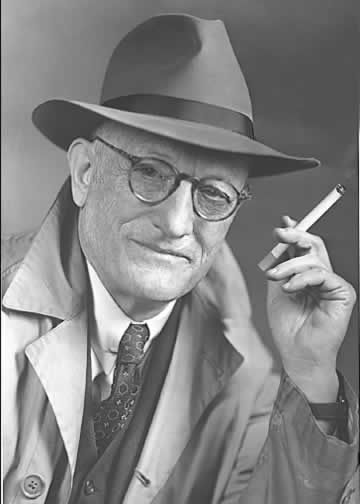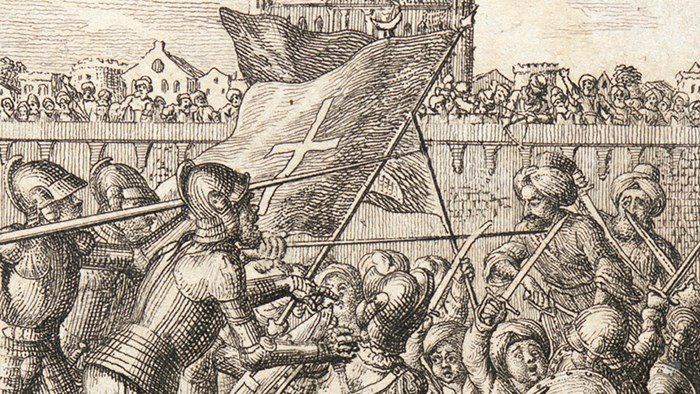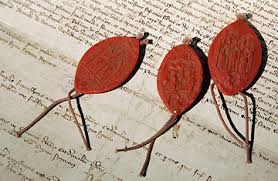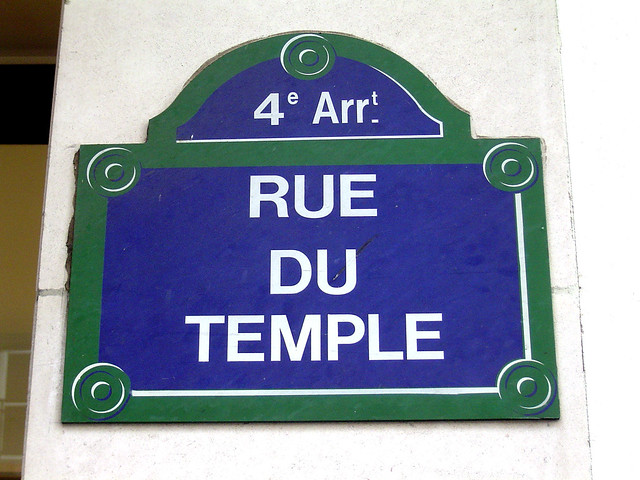Two days ago, I published an article in which I referred to Norman Vincent Peale (1898-1993). I explained the link between Peale and the pernicious closed-logic fairy story which, over the decades, has been peddled to millions of ill-informed transient adherents of 'Multi-Level Marketing/ Prosperity Gospel' cults. I also explained the worrying influence that Peale, and his pseudo-psychological preachments, still have over Donald Trump.
Yesterday, I received an abusive comment from an anonymous reader who claims to have 'built a global (MLM direct sales) business and earned a ton of money guided by Dr. Peale's self-help philosophy contained in his wonderful books and videos of his lectures.'
The following is my response to this irate 'MLM' propagandist who insists that I'm 'a jealous loser' who doesn't know the first thing about 'one of the greatest Americans.'
_________________________________________________________________________
Norman Vincent Peale was born in Bowersville, Ohio. He attended Bellefontaine High School, Bellefontaine, Ohio. After obtaining a degree in English at Ohio Wesleyan University, he briefly worked as a trainee journalist in Detroit. However he then decided to follow his father and become a Methodist minister. He attended Boston University School of Theology and, in 1924, he was ordained pastor and given his first church in Brooklyn. At about this time, he was invited to join the 'Freemasons.'
Peale was initiated to the level of 'Master Mason' on March 3, 1926, in Midwood 'Freemasonic' Lodge No. 1062 (which eventually consolidated, in 1970, with Lexington Lodge No. 310 to become Midwood Lodge No. 310).
Peale moved to another Methodist church and completed the degrees of the 'Scottish Freemasonic Rite' in the Valley of Syracuse in 1928 (affiliated with the Valley of New York City in 1934).


In 1932, Peale became pastor at the 'Marble Collegiate Church' in Manhattan. Although the building dated from the 19th century, this was a continuation of the first 'Reformed Protestant Dutch Church' to be founded in N. America in the 17th century.
In 1935, Peale started a radio show called The Art of Living. The show ran for 54 years. When television began, supported the 'National Council of Churches,' Peale moved his broadcasts to the new medium.
 |
| Dr. Smiley Blanton. |
In 1940, Peale produced the first in a short series of books in collaboration with a qualified medical practitioner/psychiatrist, Dr. Smiley Blanton (a former patient of Sigmund Freud), entitled 'Faith Is the Answer: A Psychiatrist and a Pastor Discuss Your Problems.'
In 1945, along with his wife, Ruth, Peale also created a non-sectarian, non-profit-making association and magazine (aimed at veterans returning from WWII) called 'Guideposts' which still exists today.
Peale was 'Grand Chaplain' of the 'Grand Freemasonic Lodge of New York,' 1948-51.
In 1951, again in collaboration with Dr. Smiley Blanton, Peale created the 'American Foundation of Religion and Psychiatry (currently known as the 'Blanton-Peale Institute').'The pair opened the 'Religio-Psychiatric Clinic' at the 'Marble Collegiate Church,' where assistance was offered to persons suffering from emotional problems (like anxiety and depression). The 'clinic' offered training to clergymen of all denominations to assist members of their congregations in dealing with emotional problems.
In 1952, Peale produced 'The Power of Positive Thinking.' He and Dr. Blanton apparently argued over the content of this book which was now widely-criticized by mental health professionals as being non-scientific. Dr. Blanton refused to endorse it, but it quickly featured on the NY Times best sellers list alongside L. Ron Hubbard's 'Dianetics The Modern Science of Mental Health' (published in 1950) with which it was widely-compared.
By the mid-1950s, Peale had become a wealthy minor celebrity in the USA. Just like L. Ron Hubbard, what he preached and peddled (a jargon-laced cocktail of 'religion' and step-by-step do-it-yourself 'self-betterment pyschology') was perfectly tailored to fit the spirit of the age. Unlike L. Ron Hubbard, who was generally perceived as an absurd charlatan, Peale enjoyed a friendly relationship with the mainstream media.
By the mid-1950s, Peale had become a wealthy minor celebrity in the USA. Just like L. Ron Hubbard, what he preached and peddled (a jargon-laced cocktail of 'religion' and step-by-step do-it-yourself 'self-betterment pyschology') was perfectly tailored to fit the spirit of the age. Unlike L. Ron Hubbard, who was generally perceived as an absurd charlatan, Peale enjoyed a friendly relationship with the mainstream media.
In recognition of his 'outstanding service to humanity,' Peale received initiation to the 'Freemasonic 33rd degree' in 1959.
In 1960, Peale briefly started to attract bad publicity when (as spokesman for 150 protestant clergymen), he loudly-opposed the election of John F. Kennedy on the grounds that he was a Roman Catholic whose prime allegiance would be to the Vatican rather than to the American people.
Peale was also a former Imperial Chaplain of the Shrine of North America and a Grand Prelate of the Grand Encampment, Knights Templar, USA.
_______________________________________________________________________________
I don't think that it is possible to understand Norman Vincent Peale's activities, without understanding 'Freemasonry.'
The leaders of the traditional 'fraternal, secret society' known as the ‘Free and Accepted Masons,’ or 'Freemasons,' have promoted the concepts of religious tolerance, democracy and respect for the rule of law. In fact, the movement has played a significant role in history (particularly, during the American, and French, revolutions, when it was a secret forum for debate). The founding, democratic values of the (current) 5th French Republic Liberty
That said, 'Freemasonry' is a self-perpetuating, non-rational, esoteric, ritual belief system, based on an essentially-fictional, closed-logic narrative, presented as fact using a constant repetition of reality-inverting key-words and images combined with pseudo-scientific mystification. Unfortunately, like all non-rational belief systems, in the wrong hands, 'Freemasonry' can be easily perverted for the purpose of human exploitation. Indeed, in certain countries (like Italy), a form of major organized-crime linked to so-called 'Black Masonic Lodges,' has been identified and (in theory) outlawed. It is also interesting to note that, although 'Freemasons' were high on the list of Adolf Hitler's imagined enemies, and were persecuted by the 'Nazi' regime, the 'Nazi Party' itself evolved out of the unification of various perverted secret societies.
Possibly the simplest way to describe 'Freemasonry' is to say that, internally, it exhibits the essential identifying characteristics of a traditional, dualistic religion, but externally the movement has been presented using non-religious terminology. Interestingly, the organization insists that it is not a religion,and 'Freemasons' now tend to make the nonsensical claim to be the members of 'society with secrets: rather than a secret society.'
That said, 'Freemasonry' is a self-perpetuating, non-rational, esoteric, ritual belief system, based on an essentially-fictional, closed-logic narrative, presented as fact using a constant repetition of reality-inverting key-words and images combined with pseudo-scientific mystification. Unfortunately, like all non-rational belief systems, in the wrong hands, 'Freemasonry' can be easily perverted for the purpose of human exploitation. Indeed, in certain countries (like Italy), a form of major organized-crime linked to so-called 'Black Masonic Lodges,' has been identified and (in theory) outlawed. It is also interesting to note that, although 'Freemasons' were high on the list of Adolf Hitler's imagined enemies, and were persecuted by the 'Nazi' regime, the 'Nazi Party' itself evolved out of the unification of various perverted secret societies.
Possibly the simplest way to describe 'Freemasonry' is to say that, internally, it exhibits the essential identifying characteristics of a traditional, dualistic religion, but externally the movement has been presented using non-religious terminology. Interestingly, the organization insists that it is not a religion,and 'Freemasons' now tend to make the nonsensical claim to be the members of 'society with secrets: rather than a secret society.'
In order to understand what is the connection between 'Freemasonry' and the 'Templars,' first of all you have to know who were the 'Templars.'

In 1099 AD, after the so-called ‘First Crusade’ and the capture of Jerusalem
'wonderful things were to be seen. Numbers of the Saracens were beheaded ... others were shot with arrows, or forced to jump from the towers... others were tortured for several days and then burned in flames. In the streets were seen piles of heads and hands and feet. One rode about everywhere amid the corpses of men and horses. Yet these were small matters compared to what happened at the Temple of Solomon. . . in the temple and the porch of Solomon, men rode in blood up to their knees and bridle reins. '
For obvious reasons, bands, or 'Orders,' of Christian soldier/monks were then needed to offer 'protection' to the many European pilgrims flocking to visit the ‘Holy Land.'
'L'Ordre des Chevaliers de la milice du Temple' a.k.a. 'Order of the Poor Knights of Christ and of the Temple of Solomon' a.k.a. the ‘Militia of Christ’ a.k.a. the ‘Order of Templars,’ was originally a band of 9 French knights led by Hugues de Payens. They acquired their name when, in 1118, the 'Christian King ofJerusalem, Temple of Solomon
'wonderful things were to be seen. Numbers of the Saracens were beheaded ... others were shot with arrows, or forced to jump from the towers... others were tortured for several days and then burned in flames. In the streets were seen piles of heads and hands and feet. One rode about everywhere amid the corpses of men and horses. Yet these were small matters compared to what happened at the Temple of Solomon. . . in the temple and the porch of Solomon, men rode in blood up to their knees and bridle reins. '
For obvious reasons, bands, or 'Orders,' of Christian soldier/monks were then needed to offer 'protection' to the many European pilgrims flocking to visit the ‘Holy Land.'
'L'Ordre des Chevaliers de la milice du Temple' a.k.a. 'Order of the Poor Knights of Christ and of the Temple of Solomon' a.k.a. the ‘Militia of Christ’ a.k.a. the ‘Order of Templars,’ was originally a band of 9 French knights led by Hugues de Payens. They acquired their name when, in 1118, the 'Christian King of
'Templar' rules were instituted in 1128 by (Saint) Bernard of Clairvaux (1091-1153). 'Templars' wore white hooded robes with a flared red cross. Externally, the Order was affiliated to the ‘Roman Catholic Church’ and answered to the authority of the 'Pope,' but it has been widely-accepted that, internally, the Order's real supreme commander, who called himself the ‘Grand Master of the Temple,' claimed to have found and decoded an ancient Egyptian, magical/geometric symbol inscribed on the fabric of Solomon's Temple by its architect, King Hiram of Tyre, which gave him exclusive access to a special knowledge derived from the ‘Supreme Architect of the Universe.' Indeed, various historians have examined the evidence and formed the opinion that the clandestine mission of the 9 'Templar' knights was to retrieve relics and manuscripts containing the secret traditions of Judaism and of ancient Egypt. Thus, the Order's founders, and their successors, were all brought up as 'Christians,' but their real beliefs were not strictly 'Christian.' They almost certainly adopted 'Black Magic' rituals, rites and sermons which were common at the time. There is a strong consensus among historians that these practises derived from the 'Cabala.'
The 'Templars' suicidal valour, and unquestioning obedience, in battle, soon became legendary. They apparently saw themselves as morally, physically and intellectually superior, not only to their enemies, but also to their allies. 'Templars' were inflexible fanatics, evidently conditioned to believe that they alone represented a force of purity and absolute righteousness derived from their Grand Master's access to a superhuman knowledge, and that progressive initiation into this knowledge, combined with unconditional deference to their 'Grand Master,' would defeat the impure forces of absolute evil and lead to exclusive, future redemption in Paradise.
In total, there were 23 'Grand Masters of the Temple.' A few retired, but many were killed in battle. Replacements were chosen by an 'electoral' system similar to that used to appoint the Doge of Venice. A group of the highest 'Templar' initiates chose a provisional 'Grand Master' whilst an 'electoral' college (drawn from the Order's international 'chapters') was formed. Eventually, after various rounds of secret voting, the next 'Grand Master' emerged.
'Templar' initiates occupied ranks in a hierarchy of command. They swore oaths of Secrecy, Celibacy and Poverty. The group was 'Sacred', non-initiates were 'Profane' (Latin pro, before or outside, fanum,the temple). Despite the façade of 'piety and poverty,' the Order began to attract the sons of wealthy families from Christendom and even converts from the Moslem world. 'Donations' poured in. The 'Grand Masters' collaborated with Venetian merchants and tax-free enterprises were developed in shipping, banking, etc.
Travel was extremely dangerous in the 12th century. Transporting money, as well as valuable commodities, was particularly risky. The 'Templars' made a fortune by means of an elementary system of banking. When a traveller wanted to go from one land to another, first he would go to the 'Templars' in his homeland with his money. In return, he was given a receipt with a coded message. On arrival at his destination, the traveller could redeem his receipt for the money he'd paid, minus a fee and interest.
The 'Templar' leaders had a monopoly on this style of banking. They became so wealthy that they began to finance European monarchs. Although lending money for interest was deemed usury, and was supposedly a forbidden activity for Christians, the 'Templars' were effectively above the law. Eventually, an infrastructure of thousands of bases, from Scandinavia to the ‘Holy Land ', was built and the organization ran its own parallel system of justice. By the mid-12th century, 'Templars' occupied immense 'Priories' close to Paris London and their power was comparable to that of most European monarchs Cyprus England. Holy Land ' in 1192, all Christian militias were gradually forced to abandon their forward strongholds and withdraw back to their European bases, becoming elite troops defending 'Christendom' from the threat of Moslem invasion - another very lucrative enterprise. It is estimated that by the 13th century, the 'Templars' numbered 160,000, of whom 20,000 were knights
At the end of the 12th century, rumours about the ‘Templars’ being heretics and usurers, secretly in league with Moslems, Jews and the Devil, had already begun to appear, but the organization remained far too powerful to be challenged. During the 13th century, the curious 'Templar' badge (two knights on a single horse) came to be widely-seen as a coded sign of homosexuality. Finally, it became an open secret that the 'Templar's' were actually the complete opposite of what they claimed to be. From 1307, 'Templars' were persecuted by King Phillipe IV ('le Bel') of France France
1. During initiation ceremonies, new 'Templars' were required to deny Christ, God, the Virgin or the Saints on the command of those receiving them.

The court records show that the majority of 'Templars' who confessed were imprisoned. However, 54 'Templar Masters' were burned alive. The Pope personally interrogated 72 of the guilty 'Templar' Knights. They were asked to swear an oath to tell the truth, before confirming that their previous confessions had been valid. They then knelt down before the Pope and asked him for forgiveness. Only after this extraordinary humiliation, was the Order dissolved in 1312 (apparently) on the command of Pope Clement V. Seized 'Templar' property was given to the ‘Knights Hospitaller.’ The last 'Grand Master of theTemple
1. During initiation ceremonies, new 'Templars' were required to deny Christ, God, the Virgin or the Saints on the command of those receiving them.
2. 'Templars' committed various sacrilegious acts either on the cross or on an image of Christ.
3. Higher 'Templar' initiates practised obscene kisses on new entrants, on the mouth, navel or buttocks.
4. Priests of the Order did not consecrate the host, and 'Templars' did not believe in the sacraments.
5. 'Templars' practised idol worship of a cat or a head.
6. 'Templars' encouraged and permitted the practise of sodomy.
7. 'Grand Master,' or other high initiates, absolved their brother 'Templars' from their sins.
8. 'Templars' held their initiation ceremonies and chapter meetings in secret and at night.
9. Templars' abused the duties of charity and hospitality and used unlawful means to acquire property and increase their wealth.
Under torture, almost all the 'Templars' confessed that:
Under torture, almost all the 'Templars' confessed that:
- they did not believe in Jesus, whom they held to be 'a false prophet'
- they had committed acts of homosexuality during the initiation and afterwards
- they worshipped idols and practised Satanism.
The court records show that the majority of 'Templars' who confessed were imprisoned. However, 54 'Templar Masters' were burned alive. The Pope personally interrogated 72 of the guilty 'Templar' Knights. They were asked to swear an oath to tell the truth, before confirming that their previous confessions had been valid. They then knelt down before the Pope and asked him for forgiveness. Only after this extraordinary humiliation, was the Order dissolved in 1312 (apparently) on the command of Pope Clement V. Seized 'Templar' property was given to the ‘Knights Hospitaller.’ The last 'Grand Master of the
After dissolution, the 'Templars' were so rich, numerous and widespread that it was effectively impossible to eradicate the organization and seize all its assets. In fear of their lives, many 'Templars' went underground. Significant numbers fled continental Europe and found refuge in Scotland. This was the only kingdom in 14th century Europe that didn't recognize the authority of the Pope. Under the protection of Robert the Bruce, 'Templars' continued to operate in secret, camouflaged as trade guild's. Outside of government and the Church, these were the most-influential organizations of the time. The 'Templars' had been heavily-involved in the extraordinary project of the Roman Catholic Church, to design and construct cathedrals all over Europe and, to this end, trade guilds had been instigated, controlled and protected by the Order. It is known that many 'Templars' escaped to Scotland disguised as tradesmen and by travelling with them. During the great period of Medieval cathedral construction, skilled masons and carpenters became an international fraternity who had the right of free-passage across borders.
Quarters ofParis London Temple.' B
Quarters of
By process of deduction, it has been assumed that 'Freemasonry' evolved from medieval trade guilds of stonemasons and carpenters, responsible for the construction of Cathedrals in Britain Scotland Scotland
Core-adherents of 'Freemasonry' are the product of co-ordinated, devious techniques of social, psychological and physical persuasion designed to shut down their critical, and evaluative, faculties and convince them that their leadership has exclusive access to a super-human knowledge derived from the Great/Supreme Architect of the Universe, via ancient Egypt and Euclidean geometry. Initiates are arbitrarily categorized as the‘Sacred', and non-initiates as the ‘Profane'.
Belief in the self-gratifying 'Masonic' myth spread throughout Europe , and then all over the globe with the British Empire . Although its adherents currently number several millions, 'Freemasonry' is generally in decline. It is still most popular in the USA Britain USA
In Catholic France, 'Freemasonry' was influenced by a parallel belief-system, 'Rosicrucianism,' and since the 19th century, the requirements of francophone 'Freemasons' have been slightly different to those of their anglophone counterparts.
Officially (outside of France), 'Freemasonry' has been perpetuated by initiating 'free-born, sane, adult males of good moral standing, who already believe in the existence of one supreme being and in the immortality of the human soul.' Recruitment has worked solely by invitation (through personal relationships) into a wheel of (apparently autonomous) sub-groups. In reality, these are unified by the same narrative. The sub-groups operate in geographically-defined enclaves. 'Freemasonry' is a vast pyramid of humans, which itself comprises ever-smaller pyramids known as 'Orders', 'Lodges', etc. The movement can, therefore, also be described as a mind-numbing game of construction played to strict, geometric rules using human building-blocks. The alleged object of 'Freemasonry' is to climb through its hierarchical levels in a system of 'obedience', and through parallel levels of 'initiation' in a system of 'outer and inner hermetic circles of secret knowledge'. Adherents are graded by 'degrees' - 'EnteredApprentices, Fellows of the Craft, and Master Masons' - which themselves are also graded by 'degrees'. These can number as many as 1000 in certain 'Lodges', but 33 is the traditional number. At the top of the pyramid, is a tiny minority of elite initiates known as 'Grand Masters' whose beliefs and behaviour are to be duplicated. Their 'ultimate, secret knowledge', derived from the ‘Great/Supreme Architect of theUniverse,’ must not be written down or passed to the uninitiated.
Thus, classically of an non-rational, esoteric, ritual belief system, the further an initiate progresses into the mental labyrinth of 'Freemasonry': the more absurd, mystifying and ultimately incomprehensible the closed-logic scenario overwhelming the critical and evaluative faculties of the core- adherents of the organization, becomes.
The following, thought stopping, anonymous statement was once sent to this Blog (presumably, by a 'Freemason'):
'Freemasonry is a society of men concerned with moral and spiritual values. Its members are taught its precepts by a series of ritual dramas which follow ancient forms and use stonemasons customs and tools as allegorical guides. The fundamental ritual consists of a drama of building King Solomon's Temple and the fate of its master architect. Using this allegory, moral lessons are taught. Since the story concerns building of a temple, Masonic rituals are replete with tools of masons, like level, plumb rule, square, compasses and so on.'
Thus, classically of an non-rational, esoteric, ritual belief system, the further an initiate progresses into the mental labyrinth of 'Freemasonry': the more absurd, mystifying and ultimately incomprehensible the closed-logic scenario overwhelming the critical and evaluative faculties of the core- adherents of the organization, becomes.
The following, thought stopping, anonymous statement was once sent to this Blog (presumably, by a 'Freemason'):
'Freemasonry is a society of men concerned with moral and spiritual values. Its members are taught its precepts by a series of ritual dramas which follow ancient forms and use stonemasons customs and tools as allegorical guides. The fundamental ritual consists of a drama of building King Solomon's Temple and the fate of its master architect. Using this allegory, moral lessons are taught. Since the story concerns building of a temple, Masonic rituals are replete with tools of masons, like level, plumb rule, square, compasses and so on.'
From its beginning, 'Freemasonry' has been frowned-on by the leaders of traditional religions and banned in many countries. It is not difficult to see why so many observers have ridiculed, and/or feared, the organization. Mystifying 'secret' rituals are performed in a 'Temple', within a 'Temple', within a'Temple' (i.e. a building, containing a locked-room, containing an arrangement of 3 columns set facing to the East on a 'mosaic' of black and white squares resembling a chess board). The innermost 'Temple Temple Temple
The capital letter 'G,' which invariably appears in 'Masonic' symbology, stands for both 'Geometry' and the 'Great Architect of the Universe,' but it is no coincidence that 'G' also stands for 'God.' Like any traditional religion, 'Freemasonry' operates its own system of justice, and 'being cast out of the Temple' (excommunication) is the highest penalty for any initiate whom the leadership judge to have broken the rules of the group.
The capital letter 'G,' which invariably appears in 'Masonic' symbology, stands for both 'Geometry' and the 'Great Architect of the Universe,' but it is no coincidence that 'G' also stands for 'God.' Like any traditional religion, 'Freemasonry' operates its own system of justice, and 'being cast out of the Temple' (excommunication) is the highest penalty for any initiate whom the leadership judge to have broken the rules of the group.
David Brear (copyright 2019)








No comments:
Post a Comment